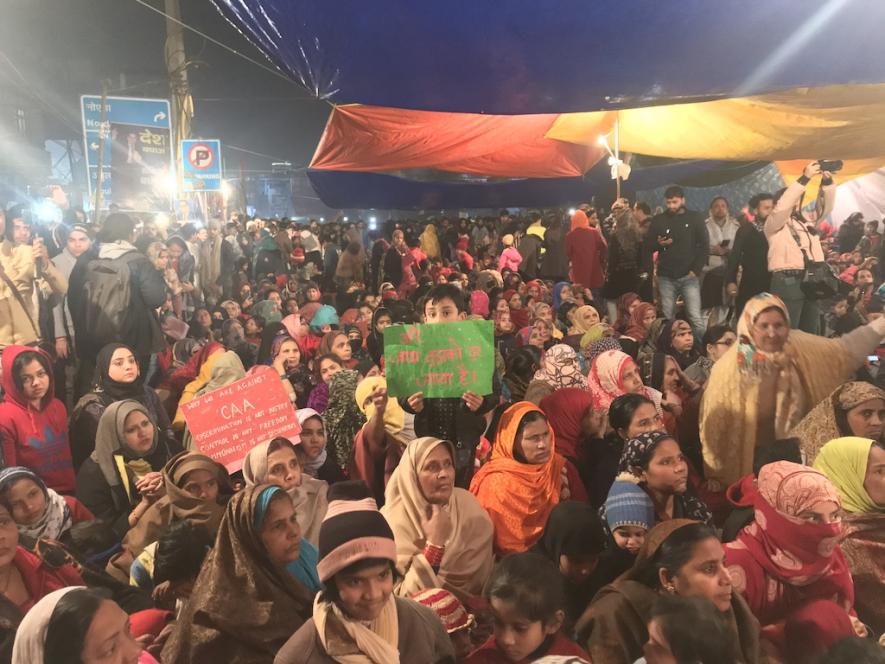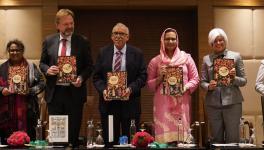Muslim Women’s Movement from Shah Bano to Shaheen Bagh

Once again, Muslim women are taking a central role in defending the Muslim community from majoritarian Hindutva aggression. In raising their voices against policing and state-backed intimidation by Hindu groups, they have emerged at the forefront of defending a victimised and beleaguered community. This time, the location is Karnataka, where the government imposed a ban on hijab on educational campuses. Young students in pre-college institutions are being forced to respond to the endless onslaught on democratic rights by the Bharatiya Janata Party-led central government and its network of right-wing organisations. While there are inspiring images of Muslim women’s resistance, they must be seen in continuity with the anti-CAA-NRC-NPR movement and the earlier movements that emerged from the Shah Bano case.
Shah Bano to Shaheen Bagh—the journey of Muslim women’s movement
In 2019, during the anti-CAA-NRC-NPR struggle, Muslim women spearheaded the agitation against the discriminatory citizenship law. Different “baghs” of protest sprang up as spaces of inclusion and diversity. We all came together with a common purpose to defeat the forces of hate. We came together to claim the values of equality and justice enshrined in the Constitution. We stood with and under the leadership of these women, recognising the power of their protest as they visibly occupied public spaces that had primarily existed in our blind spots.
Dress codes have always been a contested issue for Muslim women. Over decades, Muslim women have fought fanatical forces within their community that dictated what to wear, what to read, where to go, whom to love. Women’s movements have long accepted the stream of thought that believes changes in laws related to family and marriage can happen from within the community and the framework of the Shariat. This makes the sudden discomfort with the hijab a little difficult to comprehend.
With the hijab becoming a highly visible symbol of the Muslim community, its assertion becomes an act of protest against Hindutva violence. Diverse voices from within the community that critique the hijab as a patriarchal practice risk being marginalised, and the agendas of religious institutions within the community become mainstream. Such a situation homogenises Muslim women’s experiences within the community: experiences of women from marginalised communities, from working-class socioeconomic backgrounds, invisiblising their contestations, their struggles within the community concerning hijab. Several people advocate that reform should come from “within communities”, yet we see communities dominated by men and religious organisations with deeply conservative attitudes towards gender and sexuality. It takes a long time to negotiate the patriarchal and religious control of family and community.
When we speak, those in power stifle our voice because they want us to be subservient. Power confronts Muslim women in every sphere of domestic and social life. Thus, the fight for and against hijab, both need to be seen as assertive acts from the standpoint of Muslim women. While the Hindu and Muslim right-wing capitalise on the hijab issue and the court verdict will create a win-win situation for one party, we must remember whether, how, and why the Muslim woman will or will not claim hijab remains her own political standpoint.
Muslim women’s organisations have long struggled against religious conservatism and patriarchy within their communities. Remember the protests against the fatwa issued against Imrana, who was raped by her father-in-law, protests against instant triple talaq. Remember the nineties, while the Hindutva forces began to shape the fabric of ‘secularism’ in India, while the State opened the gates of free-market capitalism when the New Economic Policy ushered in neo-liberal beliefs, and the film, ‘Fire’, made queer lives visible. The decade was also rife with debates on the Uniform Civil Code, over women’s right to choose, their sexuality.
Yet, one feels that organisations working with Muslim communities over the past decades have not engaged significantly on the subject of religion. We always found ways to navigate the issue without really critiquing it incisively. As the Rashtriya Swayamsevak Sangh (RSS) gains ground, setting new terms of citizenship and secularism, we felt, ‘Now is not the right time to have this discussion’. Or, we engaged with the subject in a manner we found convenient. With the BJP government coming to power in 2014, we realised we did not understand the subject’s urgency and had delayed opening up to it for too long. We must acknowledge that we have been hesitant to grapple with religion over the years.
Contestations within
An alternative to reform solely from within the community has been to implement the principles enshrined in the Constitution. For Muslim women, who are marginalised within a marginalised community, we look towards the implementation of constitutional rights, not towards the interpretations of verses in the Quran, nor towards reforming religious institutions that dominate our community. We do not think it necessary to draw from religious institutions to gain legitimacy for what is or is not “a practice” or what is or is not “essential”.
Now, with the State deviating from constitutionalism and on the road to Hindu majoritarianism and authoritarianism, the space to demand implementation of the Constitution is greatly reduced. There is a loss of faith in the secular functioning of the State and the autonomy of the judicial system due to repeated acts of violence against the Muslim community—from the Delhi violence to the arrests of several innocent students and activists under fake terror charges, to name only a few incidents. Is it necessary to say more when BJP leader and Minister of State Anurag Thakur, who chanted “Goli maaro saalon ko” during the BJP’s poll campaign in Delhi, was rewarded with the post of a Union Minister?
In the context of explicit disregard for Muslim lives, which takes the form of bloodthirsty anti-Muslim riots and lynchings, along with the never-ending list of discrimination and intimidation in social life, questions of gender justice and reform from within the community have been forced to take the back seat. Our experiences as activists who have spent several decades working with Muslim women reveal the difficulty of demanding reform and change from within the community. We tried to carve out a space to discuss how the Muslim Personal Law discriminates against women, raising issues of polygamy, triple talaq and halala. Muslim women’s organisations challenged not only their families but ulemas, qazis and religious institutions like the All India Muslim Personal Law Board.
We also struggled against the compulsory wearing of the hijab, along with restrictions on mobility, education and freedom to choose partners. As activists who work within the Muslim community, we ask ourselves, how can we defend our community without side-lining questions of gender justice within the community? As the assertion of identity itself has become a political act, we also seek to maintain a different understanding of what being a “Muslim” means—one that encompasses socioeconomic factors like employment, livelihood, education and access to healthcare.
As the political violence of Hindutva dissolves the boundary between community and individual, the individual becomes the community and the community the individual. We fear that the space for discussion, dissent and sharing of multiple voices is slowly vanishing, both within the Muslim community and society as a whole. The space for Muslim women to demand constitutional rights and engage in a productive dialogue with the State to bring about gender-just reform has all but disappeared. The assertion of identity, which is an act of resistance in the face of discrimination and hate crimes, must consider multiple voices and criticisms of the community to prevent the notion of being a “Muslim” from becoming a singular identity defined by religious groups.
How can we maintain our resistance to the majoritarianism of the State without losing our critique of patriarchal practices?
Over the years, we have also seen the BJP attempt to appropriate Muslim women’s struggles. We have resisted this appropriation and countered the onslaught on the human rights of the Muslim community, which has become severe ever since the BJP came to power. We face challenges on numerous fronts. Muslim women were targeted online through the Bulli Bai app, and earlier, a similar app (Sulli Deals) was created to target them. This month, we are seeing attempts to enforce segregation and apartheid in places of learning. These questions become all the more urgent as we stand on the verge of the Uniform Civil Code once again becoming the agenda of the Hindutva brigade to further criminalise and marginalise the community.
While the Hindutva forces would attempt to appropriate our voices to further their own agenda, we would also have to be prepared to counter their moves as it will be detrimental to women’s rights and the rights of sexual minorities.
Struggle Against Hindutva Fascism and Fight Against Patriarchy
The Budget Session of Parliament stands testimony to the tremendous drawbacks in the government’s economic planning. Its failures will affect large sections of the Muslim community, which is already staggering economically, as every survey and statistic shows, and as anticipated by the constant attacks on their livelihoods. There are elections in various states (importantly, Uttar Pradesh) where, in some areas, we are also seeing a strong anti-incumbency sentiment. One of tomorrow’s biggest challenges is how we can strategise our actions to fight the anti-people agenda that the BJP is pushing on various fronts. Today, the Muslim women who wear the hijab are fighting the Hindu-supremacist regime, which has only strengthened over the years and systematically targeted the community. We have not forgotten Muslim women’s struggles and numerous battles, the crucial one being the struggle against religious institutions and clerics who try to enforce religious identity on women’s bodies.
The tendency of many of us to cite examples from West Asian countries to illustrate our point about hijab is mistaken: the conditions of Indian Muslims are very different economically, socially and politically. Giving such instances is to draw false equivalences. We must remember that what is happening in Karnataka is orchestrated by the state government, with the support of Hindutva groups. The toxic masculinity on display is being promoted to stifle the voices of Muslim women and her struggle for dignity. At this juncture, when young Muslim women and girls are being constantly targeted and denied their fundamental right to education, we need to stand in unconditional solidarity with them.
We may have differences of opinion and points of view regarding the hijab or burkha, but we need to keep in mind the political project of the Hindutva regime, which is moving closer each day towards the extermination of Muslims.
Therefore, a very rigorous discussion needs to take place amongst us. I wish voices of women working at the grass-roots level in towns and rural areas are also part of this discussion. These women came out in large numbers against the fatwas of Imrana and Gudiya. Often, these voices are not part of the more extensive discussions. To grasp these developments more comprehensively, we need to engage and listen to the voices from the grass-roots and sharpen our fight against patriarchy within the community—and the Fascistic onslaught of the Hindutva government.
(With many thanks to comrades and friends Jhelum, Sudeeti and Hamza, without whose insights this article could not have been written.)
The author is founder-member, Bebaak Collective. The views are personal.
Get the latest reports & analysis with people's perspective on Protests, movements & deep analytical videos, discussions of the current affairs in your Telegram app. Subscribe to NewsClick's Telegram channel & get Real-Time updates on stories, as they get published on our website.
























